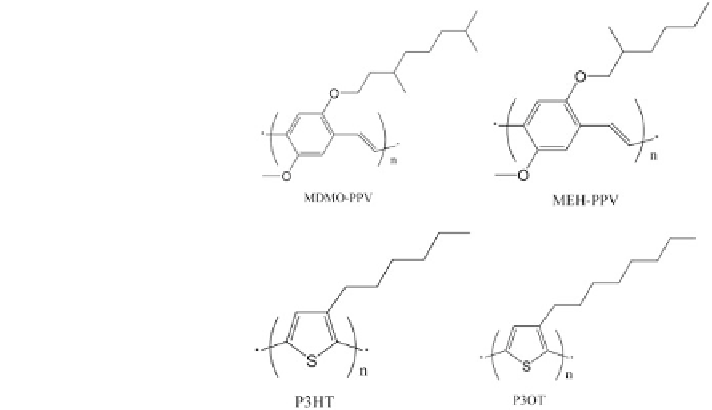Environmental Engineering Reference
In-Depth Information
Fig. 9.4 Molecule structures
of the four common used
conjugated polymers in
hybrid solar cells
micromorphologies, i.e., nanoparticles, nanorods and nanorod-, nanowire-, and
nanowire arrays. The micromorphologies of inorganic nanocrystals may have pro-
found effect on the performance of HSCs [
9
,
48
].
9.3.1 Nanoparticles
The charge separation and transport in the conjugated polymer/semiconductor
nanocrystals composites were first studied by Greenham et al. in 1996 [
8
]. A HSC
with ITO/MEH:PPV-CdSe/Al structure was fabricated, after incorporating 90 wt%
of CdSe into the polymer matrix the device gave a 0.6 % PCE and a 12 %
quantum efficiency at 514 nm, while the PCE could only approached 0.1 % under
80 mW/cm
2
white light. After the breakthrough in control the shape of CdSe
nanocrystals, CdSe quantum dots (QDs), nanorods, and tetrapods have been
extensively studied [
49
-
51
]. Compared to the earlier CdSe QDs based HSCs, the
PCEs have been improved by an order of magnitude, through the modification of
CdSe QDs and the use of new polymers [
52
-
54
], however, the elongated CdSe
nanocrystals were found to have better charge transport properties than nanopar-
ticles, consequently drew more attention [
9
,
10
,
12
,
48
].
Triggered by the research on CdSe nanocrystals, charge transport properties in
TiO
2
/polymer heterojunction were also studied and photoinduced charger transfer
from conjugated polymers to TiO
2
was confirmed to be possible [
55
-
57
]. Mesoporous
TiO
2
film with a uniform pore distribution was prepared with the block polymer
template (Fig.
9.5
) and used for preparing HSCs by infiltrating P3HT into the pores, a
monochromatic PCE of 1.5 % was obtained at 33 mW/cm
2
514 nm illumination and
an efficiency of 0.45 % was estimated under AM 1.5 condition [
16
,
17
]. Besides, many

Search WWH ::

Custom Search